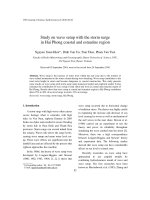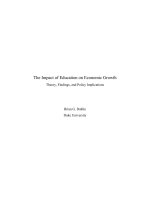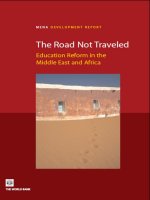The Road Not Traveled Education Reform in the Middle East and North Africa pot
Bạn đang xem bản rút gọn của tài liệu. Xem và tải ngay bản đầy đủ của tài liệu tại đây (3.15 MB, 399 trang )
Washington, D.C.
The Road Not Traveled
Education Reform in the
Middle East and North Africa
MENA DEVELOPMENT REPORT
©2008 The International Bank for Reconstruction and Development / The World Bank
1818 H Street NW
Washington DC 20433
Telephone: 202-473-1000
Internet: www.worldbank.org
E-mail:
All rights reserved
1 2 3 4 11 10 09 08
This volume is a product of the staff of the International Bank for Reconstruction and Develop-
ment / The World Bank. The findings, interpretations, and conclusions expressed in this volume
do not necessarily reflect the views of the Executive Directors of The World Bank or the gov-
ernments they represent.
The World Bank does not guarantee the accuracy of the data included in this work. The
boundaries, colors, denominations, and other information shown on any map in this work do not
imply any judgement on the part of The World Bank concerning the legal status of any territory
or the endorsement or acceptance of such boundaries.
Rights and Permissions
The material in this publication is copyrighted. Copying and/or transmitting portions or all of
this work without permission may be a violation of applicable law. The International Bank for Re-
construction and Development / The World Bank encourages dissemination of its work and will
normally grant permission to reproduce portions of the work promptly.
For permission to photocopy or reprint any part of this work, please send a request with com-
plete information to the Copyright Clearance Center Inc., 222 Rosewood Drive, Danvers, MA
01923, USA; telephone: 978-750-8400; fax: 978-750-4470; Internet: www.copyright.com.
All other queries on rights and licenses, including subsidiary rights, should be addressed to the
Office of the Publisher, The World Bank, 1818 H Street NW, Washington, DC 20433, USA; fax:
202-522-2422; e-mail:
ISBN: 978-0-8213-7062-9
eISBN: 978-0-8213-7063-6
DOI: 10.1596/978-0-8213-7062-9
Cover photo: ©Nacho Hernandez, VeniVidiPhoto.
Library of Congress Cataloging-in-Publication data has been applied for.
For the analysis throughout the report, the authors mainly used data for the period of 1970-2003.
Education data during this period for Saudi Arabia might underestimate the recent achievements
in the country. New data (2004 onward) using a new methodology show significantly positive dif-
ferences over previous years. However, the authors used 2003 data because of the impossibility of
building a consistent time series from the 1970s. The CD-ROM accompanying this report con-
tains a broader and updated dataset that ranges from 1950 to 2006.
Contents
Foreword xv
Acknowledgments xix
Abbreviations xxi
Overview 1
P
ART IINTRODUCTION 7
Chapter 1: Investment in Education 9
Investment in Education and the Level of Human Capital 9
Investment in Education and the Quality of Human Capital 17
Investment in Education and the Distribution of
Human Capital 23
Investment in Education and Noneconomic Outcomes 31
Summing Up 31
Endnotes 34
References 35
Chapter 2: Economic Returns to Investment in Education 39
Education and Economic Growth 39
Education and Income Distribution 54
Education and Poverty Reduction 65
Summing Up 75
Endnotes 76
References 77
iii
iv Contents
Chapter 3: New Challenges Facing the Education Sector
in MENA 83
Globalization, Education, and the Knowledge Economy 84
Education and the Knowledge Economy 86
Demographic Changes in MENA and Education 95
Education Finance 102
Summing Up 110
Endnotes 111
References 112
P
ART II INTRODUCTION 115
Chapter 4: Analytical Framework 117
Three Building Blocks 118
Applicability of the Approach across Levels of Education
and Countries 130
Summing Up 134
Endnotes 134
References 135
Chapter 5: The Road Traveled Thus Far in MENA 137
The Path Taken So Far: A Qualitative Story 138
The Path Taken So Far: A Quantitative Story 149
Summing Up 154
Annex 5.A 155
Endnotes 162
References 162
Chapter 6: Why Some MENA Countries Did Better
than Others 165
Variations in Education Outcomes among MENA
Countries 166
Methodology for Ranking Countries 166
Contrasting Education Outcomes with the Features of
Education Systems 180
Summing Up 203
Endnotes 204
References 205
Contents v
PART III INTRODUCTION 209
Chapter 7: Education and Domestic Labor Markets 211
Education and Key Labor Market Outcomes in MENA 212
Population Growth, Employment Creation, and
Education Expansion in MENA 220
Labor Market Policies 224
Summing Up 239
Endnotes 240
References 240
Chapter 8: Education and Migration 245
The Nature of International Migration in MENA 246
The Economic Impact of Migration: A Win-Win Game 259
Why Isn’t More of a Good Thing Happening? 271
Summing Up 275
Endnotes 277
References 277
Chapter 9: The Road Ahead 281
From Engineering Inputs to Engineering for Results 284
From Hierarchical Control to Incentive-Compatible
Contracts 286
Accountability to the State versus Accountability to the
Public: Education Has a New Boss 292
Synchronizing Human Capital Accumulation with
Labor Demand 296
Getting Started Down the Road of Reform 297
Endnotes 298
References 299
Statistical Appendix 301
Index 345
List of Tables
Table 1.1 Average of Public Expenditure in Education
as a Percentage of GDP, 1965–2003 11
Table 1.2 Public Expenditure per Student by Level
of Education and Ratio of Expenditure for
Secondary/Primary and Tertiary/Primary, 2000 12
vi Contents
Table 1.3 Access to Primary School Education:
Net Enrollment Rate, Repetition Rate, and
Pupils Reaching Grade Five, 1970–2003 13
Table 1.4 Gross Enrollment Rates in Secondary and
Tertiary Education, 1970–2003 15
Table 1.5 Average Years of Schooling of the Total
Population Aged 15 and Over, 1960–2000 16
Table 1.6 Average Test Scores of TIMSS and PISA,
GDP/Capita (2003), and Gross Secondary
Enrollment Rate 19
Table 1.7 Test Scores of TIMSS and PISA Unadjusted,
and Adjusted for GDP/Capita Ordered by
Residuals 20
Table 1.8 Distribution of University Students by Field
of Study 21
Table 1.9 Illiteracy Rates of the Population Aged 15 and
Over by Gender, 1980–2000/04 23
Table 1.10 Distribution of Education, 1970–2000 25
Table 1.11 Enrollment Rates for Poor and Nonpoor 26
Table 1.12 Private Enrollment Share in Primary,
Secondary, and Tertiary Education as a
Percentage of Total Enrollment, 1980–2003 27
Table 1.13 Gender Parity Index of Gross Intake Rate to
Grade 1, Gross Enrollment Rate, and
Repetition Rate in Primary Education 29
Table 1.14 Gender Parity Index of Gross Enrollment Rate
in Secondary and Tertiary Education 30
Table 2.1 Cross-Country Growth Regression Results 44
Table 2.2 GDP per Capita Growth 45
Table 2.3 Total Factor Productivity Growth by Region,
1960s–1990s 46
Table 2.4 Scientific and Technological Capacities in
World Regions 51
Table 2.5 Income Distribution, 1960–2003 57
Table 2.6 Income Distribution as Measured by Ratio
of Income Earned by Highest 20 Percent of
Income Earners to Lowest 20 Percent of
Income Earners, 1995–2002 59
Table 2.7 Gini Coefficients of the Distribution of
Education, 1970–2000 60
Table 2.8 Private and Social Rates of Return to
Education by Level of Education,1970s–1990s 63
Contents vii
Table 2.9 Female Labor Force Participation Rates,
1980–2003, by Country 64
Table 2.10 Share of People Living on Less than $1
and $2 per Day by Region, 1981–2001 66
Table 2.11 Proportion of Population under Poverty
Line, 1990s 68
Table 2.12 Fertility Rates, 1962–2003 73
Table 5.1 Distribution of Reform Measures by Levels
of Education, Percent 150
Table 5.2 Distribution of Reform Measures by
Objectives of Education, Percent 151
Table 5.3 Distribution of Reform Measures by Type
of Reform over Time, Percent 152
Table 5.4 Distribution of Reform Measures by Sector
over Time, Percent 152
Table 5.5 Distribution of Reform Measures by
Objective and Reform Phases, Percent 153
Table A.1 The MENA Education Reform Database 158
Table A.2 Examples of Engineering Measures 159
Table A.3 Examples of Incentives 160
Table A.4 Public Accountability Measures and
Examples 161
Table 6.1 Engineering Features of the Education
Systems in Selected MENA Countries 182
Table 6.2 Primary Teacher Stocks, Flows, and
Additional Teachers Needed to Reach UPE
by 2015 188
Table 6.3 Locus of Decision Making in Basic and
Secondary Education 195
Table 6.4 Regulations Affecting Private Schools,
mid-1990s 196
Table 6.5 Industrial Organization Features of the
Education Systems in Selected MENA
Countries 197
Table 7.1 Distribution of the Labor Force and the
Unemployed in Selected MENA Economies,
by Education 214
Table 7.2 Private Rates of Return to Schooling in
MENA Countries, by Gender and Sector 216
Table 7.3 Rates of Return to Education across a
Sample of Countries 217
Table 7.4 Female Labor Force Participation Rates,
1980–2004 222
viii Contents
Table 7.5 Employment Elasticity of Growth in MENA
versus Other Regions, 1990–2004 224
Table 7.6 Public Sector Employment in MENA 226
Table 7.7 Overall Trade Restrictiveness Index (OTRI)
for MENA and Other Developing
Countries, 2001 236
Table 7.8 Growth in Informal Sector in Egypt by
Education, 1990–1998 238
Table 8.1 International Migration Trends, 2000 246
Table 8.2 Net Migration in Selected MENA Countries,
1970–2000 247
Table 8.3 International Migration in MENA,
1970–2000 248
Table 8.4 Foreign Labor Force in the Gulf States,
1975-2000 249
Table 8.5 Share of Arabs in Total Foreign Population
in the Gulf States, 1975 and 2002 249
Table 8.6 The Distribution of the Labor Force by
Arab and Asian Origin in Kuwait, 1989 and
2000 250
Table 8.7 Temporary Egyptian Migrants by Receiving
Country, 2000 251
Table 8.8 Occupation of Egyptian Migrants in Arab
Countries, 1985 and 2002 251
Table 8.9 Work Permits Granted to Egyptians in
Some Arab Countries by Occupation,
1985–2002 252
Table 8.10 Distribution of Migrants by Educational
Level in Selected MENA Countries,
Various Years 252
Table 8.11 Population from North Africa in Selected
EU Countries 253
Table 8.12 Moroccan Migrants in Main OECD
Countries, 2002 254
Table 8.13 Egyptian Migrants in OECD Countries, 2000 255
Table 8.14 Immigrants (Aged 15 and Over) in Canada
by Country of Birth and Level of Schooling,
2001 255
Table 8.15 Stocks of Foreign and Foreign-Born Labor
in the Labor Force of Selected OECD
Countries, 1992–2001 258
Table 8.16 Workers’ Remittances, 1990–2003 263
Contents ix
Table 8.17 Workers’ Remittances Received by
Developing Countries by Region, 1999–2004 264
Table 8.18 Emigration Rates from MENA to OECD
by Educational Level, 1999 and 2000 270
Table 8.19 Emigration Rates to OECD and Selectivity
by Region, 2000 271
Table 8.20 Probability of Obtaining Skilled Jobs:
Different Cohorts and Education Levels
for Selected Countries, 1970–1990 274
Table A.1 Pupil-Teacher Ratio in Primary Education,
1970–2004 308
Table A.2 Pupil-Teacher Ratio in Secondary Education,
1970–2003 309
Table A.3 Pupil-Teacher Ratio in Tertiary Education,
1970–2002 310
Table A.4 Percentage of Trained Teachers in
Primary Education, 1998–2003 311
Table A.5 Percentage of Trained Teachers in
Secondary Education, 1998–2003 311
Table A.6 Public Expenditure in Education as
Percent of GDP, 1970–2003 312
Table A.7 Public Expenditure in Education as Percent
of Government Spending, 1980–2003 313
Table B.1 Gross Enrollment Rate in Primary Education,
1950–2004 314
Table B.2 Gross Enrollment Rate in Secondary
Education, 1950–2003 316
Table B.3 Gross Enrollment Rate in Tertiary Education,
1970–2003 318
Table B.4 Net Enrollment Rate in Primary Education,
1970–2004 319
Table B.5 Gross Intake Rate to Grade 1, 1970–2003 320
Table C.1 Gender Parity Index of Primary Gross
Enrollment Rate, 1960-2003 321
Table C.2 Gender Parity Index of Secondary Gross
Enrollment Rate, 1960–2003 322
Table C.3 Gender Parity Index of Tertiary Gross
Enrollment Rate, 1970–2003 323
Table C.4 Gender Parity Index of Gross Intake Rate,
1970–2003 324
Table C.5 Gender Parity Index of Repetition Rate in
Primary Education, 1970–2003 325
x Contents
Table D.1 Survival Rate to Grade 5, 1970–2003 326
Table D.2 Primary Completion Rate, 1990–2003 327
Table D.3 Repetition Rate in Primary Education,
1970–2003 328
Table D.4 Repetition Rate in Secondary Education,
1970–2003 329
Table D.5 Dropout Rate in Primary Education,
1975–2004 330
Table D.6 Dropout Rate in Secondary, Lower
Secondary, and Upper Secondary
Education, 1975–2004 331
Table D.7 Private Enrollment Share in Primary
Education, 1985–2003 332
Table D.8 Private Enrollment Share in Secondary
Education, 1975–2003 333
Table D.9 Private Enrollment Share in Tertiary
Education, 2000–2003 334
Table E.1 TIMSS Score in Math of 8th Grade,
1995, 1999, and 2003 335
Table E.2 TIMSS Score in Science of 8th Grade,
1995, 1999 and 2003 336
Table E.3 Adult Literacy Rate (Aged 15 and Older),
1955–2004 337
Table E.4 Average Years of Schooling of Adults,
1960–2000 338
List of Figures
Figure 1.1 Fertility and Mortality Rates and Life
Expectancy, 1960–2004 32
Figure 2.1 Size of Government around the World
by Region, 1990s 53
Figure 2.2 Public Sector Employment as a Share of
Total Employment in MENA Countries 53
Figure 2.3 Ratio of Public Spending per Student in
University Compared to Primary School,
1980 and 2000 62
Figure 2.4 Economic Growth and Poverty Reduction
by Region, 1980–2000 67
Figure 2.5 Average Annual Reduction in Incidence
of Poverty Associated with 1 Percent
Increase in Average per Capita Consumption 70
Contents xi
Figure 2.6 Population Growth Rate by Country and
Region, 1970–79 and 1990–2003 74
Figure 3.1 Knowledge Economy Index with the
Breakdown of Index of Four Pillars 85
Figure 3.2 Demand for Job Skills is Changing Rapidly 87
Figure 3.3 Percent of Youth Population by Region,
1950–2050 96
Figure 3.4 Population Pyramid of MENA and the
World, 2002 97
Figure 3.5 Changes in the Age Group (6–11) Population
in Selected MENA Countries, 1950–2050 98
Figure 3.6 Education Attainment in the Population in
MENA (Weighted Average), Age 25 and
Above, 1975, 1985, and 2000 99
Figure 3.7 Education Attainment of Adult Population
for Selected MENA Countries, 2030 101
Figure 3.8 Public Spending on Education in MENA,
Most Recent Year during 1999–2003 104
Figure 3.9 Evolution of the Proportion of Private
Primary Education in 1990 and 2002 106
Figure 3.10 The Absolute Value of Average Costs per
Student in MENA and Non-MENA
Countries, US$ (PPP) 107
Figure 3.11 Spending per Pupil as a Proportion of GDP
per Capita in MENA and Non-MENA
Countries, Percent 107
Figure 3.12 Pupil-Teacher Ratio by Level of Education,
1970–2002 108
Figure 3.13 Historical Enrollment of Students in
Primary, Secondary, and Tertiary Education 109
Figure 3.14 Projection of the Number of Students
Completing Secondary School in Selected
MENA Countries 109
Figure 4.1 The Three Building Blocks of the Analytical
Framework 118
Figure 4.2 Three Actors and Three Contractual
Relationships 122
Figure 4.3 The Three Building Blocks of the
Analytical Framework 123
Figure 6.1 Primary Net Enrollment Rates and
Secondary and Tertiary Gross Enrollment
Rates, in 1970 and 2003 169
xii Contents
Figure 6.2 Integrated Index for Access 170
Figure 6.3 Gender Parity Indices of Primary, Secondary,
and Tertiary Gross Enrollment Rates, in 1970
and 2003 172
Figure 6.4 Gini Coefficients of Average Years of
Schooling, 1975 and 2000 173
Figure 6.5 Integrated Index for Equity 174
Figure 6.6 Primary Completion Rate, 1990 and 2003 175
Figure 6.7 Adult Literacy Rates and TIMSS 2003
Mathematics and Science Average Scores 177
Figure 6.8 Integrated Index for Quality 178
Figure 6.9 Integrated Index for Access, Equity,
Efficiency, and Quality 179
Figure 6.10 Average Percentage of Total Instructional
Time Allocated to Religious Education and
Morals in Grades 7 and 8, by World
Regions, 2000 185
Figure 6.11 Educational Outcomes and Political
Accountability 201
Figure 7.1 Unemployment in MENA, 2004 213
Figure 7.2 Distribution of the Labor Force and the
Unemployed in MENA by Education 214
Figure 7.3 Real Wages in Manufacturing in MENA,
1985–2003 219
Figure 7.4 Dynamics of Labor Supply in MENA
Countries, 1950–2020 221
Figure 7.5 Private Sector Contribution to GDP,
Early 2000s 229
Figure 7.6 Contract Enforcement Procedures, 2004 231
Figure 7.7 World Bank MENA Index of Quality of
Public Sector Administration 2004,
by Region 231
Figure 7.8 World Bank MENA Region’s Index of
Public Sector Accountability 2004 232
Figure 7.9 Difficulty with Hiring and Firing in MENA 233
Figure 7.10 Non-oil Exports as a Proportion of GDP,
1990 and 2003 235
Figure 8.1 Occupation of Foreign Born by Country of
Birth in the United States, 2000 256
Figure 8.2 Top 20 Developing-Country Recipients of
Workers’ Remittances, 2003 262
Figure 8.3 Top 20 Country Sources of Remittance
Payments, 2003 262
Contents xiii
Figure 8.4 Per Capita Migrants’ Remittances by
Region, 1998–2002 264
Figure 8.5 Expatriate Rate, 2005 267
Figure 8.6 Stock of Emigrants from MENA to OECD
by Educational Level, 1990 and 2000 268
Figure 8.7A Probability of Unemployment by
Educational Level in Egypt, 1998 269
Figure 8.7B Probability of Unemployment by
Educational Level in Morocco, 1999 269
List of Boxes
Box 3.1. Flexibility of Vocational Education and
Training (VET) Systems in Selected
MENA Countries 91
Box 4.1 Teacher Incentives Work, but Not Always 127
Box 4.2 Report Cards and School-Self Assessments
Strengthen Parental Involvement and
Community Mobilization 129
Box 4.3 Well-balanced Reform Approach: Successful
Case of Bogotá in Colombia 132
Box 5.1 Education in the Constitutions of Selected
MENA Countries 134
Box 5.2 Different Paths to Arabization in the
Maghreb Countries 137
Box 6.1 Summary of Pedagogical Reforms in Tunisia,
Jordan, Egypt, and Iran 183
Box 6.2 Information and Communication
Technologies and Education 186
Box 6.3 Private Tutoring in Egypt 190
Box 6.4 School Autonomy Matters: Examples from
International Experiences 194
Box 9.1 Learning from Successful Private Schools:
The Case of Fe y Alegria in Venezuela 289
Box 9.2 Information is a Key to Promoting
Accountability in Education: The Case
of Uganda 295
Education is at the crossroads for the future of the Middle East and
North Africa (MENA). It plays a crucial role in promoting poverty alle-
viation and economic growth, both at national and at household levels. It
reflects the aspirations of the people for a successful integration into the
global economy in an ever changing world. Various stakeholders in the
region regard education as their most important development challenge,
and education reform is at the top of the reform agenda of many regional
governments.
Education is also a strategic priority for the World Bank in the
MENA region and worldwide. The preparation of this report has bene-
fited from the experience accumulated from Bank collaboration with the
region in education—a relationship that has lasted for more than 40
years. Tunisia received in the early 1960s the first World Bank loan for
any education project. The preparation of this report has also benefited
from the support of a network of scholars, practitioners, and opinion
leaders, within and outside the region, who applied their knowledge and
expertise to the challenge of education in MENA.
This report traces the successes and the challenges facing the devel-
opment of education to identify promising education reform options for
the future. It is grounded in a new paradigm that is expected to increase
the effectiveness of reform efforts: It emphasizes the central role of in-
centives and public accountability to meet sector goals. Most reforms in the
region have attempted to engineer changes in the education system:
building schools, hiring teachers, and writing curricula. The success of
future reforms will require instead changes in the behavior of key educa-
tion actors—teachers, administrators, and educational authorities. This
is the road not traveled in the education sector.
Since the early 1960s, the MENA region has registered tremendous
gains in terms of more equitable access to formal education. In the 1950s,
very few children, particularly girls, were attending formal schools. Now
Foreword
xv
xvi Foreword
most countries in MENA register full or close to full enrollment in basic
education and secondary and tertiary education rates equivalent to coun-
tries in other regions at comparable levels of development. Moreover,
the region no longer has severe gender disparities in secondary and ter-
tiary education. As a result, most MENA countries have been able to
achieve a significant decline in fertility and infant mortality, as well as a
rapid increase in life expectancy. The World Bank is proud of being a
partner of the region over the course of this impressive evolution.
Notwithstanding these successes—and the considerable resources in-
vested in education—reforms have not fully delivered on their promises.
In particular, the relationship between education and economic growth
has remained weak, the divide between education and employment has
not been bridged, and the quality of education continues to be disap-
pointing. Also, the region has not yet caught up with the rest of the world
in terms of adult literacy rates and the average years of schooling in the
population aged 15 and above. Despite considerable growth in the level
of educational attainment, there continues to be an “education gap” with
other regions, in absolute terms.
In addition, new challenges are on the horizon. First, and most im-
portant, the MENA region now has one of the largest cohorts of young
people in the world, in proportion to its population. As this cohort works
its way through the education system, it will generate unprecedented de-
mands for new learning opportunities and even stronger expectations of
better results. Second, globalization has led to a demand for a different
mix of skills and competencies, and this will influence the content and
nature of what education systems should provide. Finally, MENA coun-
tries are already spending a fairly large share of public resources on
education—additional demand for better services will require greater ef-
ficiencies and a diversification of funding.
Of course education reform alone cannot be the answer for all these
challenges. In addition, the right conditions need to be created for edu-
cation reform to have its full effect. This report examines one of the most
critical prior conditions—a well-functioning labor market. In the case of
MENA, the relevant labor market extends much farther than the con-
fines of any country or even the region because of important migration
trends and opportunities. This report argues that reforms in this area will
need to be implemented hand-in-hand with those for the education sys-
tem proper.
Having succeeded in expanding the education systems to include most
eligible children—boys and girls—the MENA region is now ready to
travel a new road. While the exact configuration of this new road will not
be the same for each country, all countries, irrespective of their initial
conditions, will require a shift from “engineering inputs” to “engineer-
Contents xvii
ing for results,” along with a combination of incentives and public ac-
countability measures, as well as measures to improve labor market out-
comes. It is our hope that this report will serve as an effective guide to
these outcomes. In traveling the road ahead, the Bank looks forward to
continuing to walk together with the MENA region, in a mutually ben-
eficial relationship.
Daniela Gressani
Vice President, Middle East and North Africa Region
The World Bank
Acknowledgments
Ahmed Galal is the principal author and team leader of this report.
Michel Welmond guided the staff research effort and contributed to the
analysis of education reforms and conclusions. Members of the core team
consisted of Martin Carnoy (human capital, economic growth, income
distribution and poverty), Soren Nellemann (new challenges facing the
education sector), Jennifer Keller (education and domestic labor mar-
kets), Jackline Wahba (education and migration), Rie Kijima (documen-
tation of education reforms), and Izumi Yamasaki (data collection and
statistical analysis). The extended team included Hussein Abdul-Hamid
and Domenec Ruiz Devesa (TIMSS analysis), David Chapman and
Suzanne Miric (teacher policy), Houcine El-Haichour (education re-
form), Iqbal Kaur (adult education and literacy), Gerold Vollmer (reli-
gion in education), Amy Luinstra (vocational training and technical edu-
cation), Elham Seyedsayamdost (conflict and education), Daniel Wagner
(out-of-school youth), Hafedh Zaafrane (education finance), Aigli
Zafeirakou (pedagogy), and Hoda Selim and Tomomi Miyajima (re-
search assistance). From inception to conclusion, the report was pre-
pared under the guidance of Michal Rutkowski (Director of the Human
Development Department in MENA). Regina Bendokat and Mourad
Ezzine (MENA Education Sector Managers) supervised the preparation
of the report. The report belongs to the MENA Development Reports
series, which is coordinated by the Office of the Chief Economist for the
Middle East and North Africa Region of the World Bank, led by
Mustapha Kamel Nabli.
The team benefited from three peer reviewers: Luis Crouch, Elizabeth
King, and Chris Thomas, as well as comments made by Farrukh Iqbal,
Jeffrey Waite, and Alain Mingat. The MENA education team provided
useful inputs and comments at different stages of report preparation. The
list includes Serap Bindebir, Peter Buckland, Mae Chu Chang, Nora
Charif Chefchaouni, Ousmane Diagana, Linda English, Luis Guillermo
xix
xx Acknowledgments
Hakim, Arun Joshi, Shinsaku Nomura, Ahmed Dewidar, Amira Kazem,
Gillian Perkins, Adriana Jaramillo, Rachidi Radji, Haneen Sayed, Mitsue
Uemura, and Ayesha Vawda. Also, the team benefited from comments
made by the participants in the regional review meeting, chaired by
Daniella Gressani, especially by Inger Andersen, Michele Armitage, Ce-
cile Fruman, Hedi Larbi, Tatyana Leonova, Akiko Maeda, Hossein
Razavi, Carlos Silva-Jauregui, Hasan Tuluy, and Jonathan Walters.
The team is also grateful to the participants in the consultative work-
shops held in the region to discuss the concept note (in Egypt, Jordan,
and Morocco), as well as the participants in a number of conferences
where the report preliminary findings were presented (in Egypt,
Lebanon, and Washington, D.C.).
The report was edited by Kate Sullivan and typeset by Carol Levie,
both of Grammarians, Inc. Production and printing were coordinated by
Rick Ludwick and Andres Ménèses of the World Bank’s Office of the
Publisher.
Last but not least, the team would also like to thank all of those who
contributed and participated in the various stages of production of this
book, in particular those in government and World Bank country offices
who kindly provided information and data.
xxi
Abbreviations
CAPMAS Central Agency of Public Mobilization and Statistics
ELMS Egypt Labour Market Survey
FDI foreign direct investment
GCC Gulf Co-operation Council
GDP gross domestic product
GER gross enrollment rate
GNI gross national income
GPI gender parity index
ICT information and communication technology
IEA International Association for the Evaluation of
Educational Achievement
ILO International Labour Organization
IPA Index of Public Accountability
ISET Instituts Supérieurs des Etudes Technologique
KEI Knowledge Economy Index
LMIC Lower Middle Income Countries
LSMS Living Standards Measurement Study
M&E monitoring and evaluation
MENA Middle East and North Africa
MoE Ministry of Education
NCLB No Child Left Behind
NER net enrollment rate
NGO nongovernmental organization
OECD Organisation for Economic Co-operation and
Development
OSCY out-of-school children and youth
OTRI overall trade restrictiveness index
PAA Prueba de Aptitud Academica
PCR primary completion rate
PETS Public Expenditure Tracking Survey
xxii Abbreviations
PIRLS Progress in International Reading Literacy Study
PISA Programme for International Student Assessment
POEA Philippines Overseas Employment Administration
PPP purchasing power parity
PTA parent–teacher association
PTR pupil-teacher ratio
SAT Scholastic Assessment Test
SIP school improvement plan
SMEs small and medium enterprises
SOE state-owned enterprise
SSA school self-assessment
TFP total factor productivity
TIMSS Trends in International Math and Science Study
TVET technical and vocational education and training
UIS UNESCO Institute for Statistics
UNDP United Nations Development Programme
UNESCO United Nations Educational, Scientific and Cultural
Organization
UNICEF United Nations Children’s Fund
UPE Universal Primary Education
USAID United States Agency for International Development
VET vocational education and training
WDR World Bank Development Report
WTO World Trade Organization
Over view
Education is a powerful force that can speed up economic growth, im-
prove income distribution, facilitate social mobility, and reduce poverty.
It can also improve the quality of life for citizens by contributing to
longer life expectancy, lower fertility and infant mortality rates, and a
more cohesive national identity. However, none of these positive out-
comes are automatic. All too often, investment in education generates
low returns to the individuals involved and society at large. Thus, while
investment in education is a necessary condition for faster development
and prosperity, it is by no means sufficient.
This MENA flagship report explores whether past investments in ed-
ucation in the region have generated their maximum economic returns,
and, if not, why they have failed to do so. Ultimately, the answers to these
questions are being sought to help policymakers chart more fruitful
strategies in the future.
To this end, the report addresses three concrete questions:
1. How much has the region invested in education over the past four
decades, and how much has this investment been translated into
higher economic growth, better income distribution, lower poverty,
and better quality of life? Also, looking ahead, is the region ready to
meet the challenges of the knowledge economy, the emerging youth
bulge, and the growing financial constraints on expanding education?
2. If the answer to the first question is that the education systems in the
region have not made optimal contributions to development nor are
they ready to meet new challenges, the next question is what can pol-
icymakers do to reverse this outcome?
3. Finally, since realizing the benefits of education depends on whether
society is able to deploy its educated labor force into productive and
dynamic activities, the last question has to do with labor markets. In
particular, are domestic labor markets and migration providing effec-
tive outlets for reaping the benefits of a more educated labor force?
1
2 The Road Not Traveled
This report focuses on the economic rather than the social and cultural
dimensions of education. Its approach in answering the questions raised
above is analytical and comparative in nature. Education outcomes in the
region are compared with education outcomes in other developing coun-
tries. The development impact of investment in education is considered
in the context of the large body of literature on the subject. The educa-
tion reform strategies in MENA are assessed on the basis of a new ana-
lytical framework. Finally, labor market outcomes are evaluated on the
basis of how well these markets function, given past reform efforts.
The second feature of the report is that it covers all levels of instruc-
tion, not just basic, secondary, or higher education. The rationale for this
broad coverage is twofold: (i) the link between human capital and eco-
nomic development depends on progress made by countries at all levels
of education, and (ii) all levels of education arguably face similar prob-
lems. They all need an efficiently functioning education process, highly
motivated and incentivized teachers and schools, and adequate voice
mechanisms for citizens to influence education objectives, priorities, and
resource allocation.
Finally, although the primary focus of the report is education, it was
important to pay special attention to domestic labor markets and migra-
tion. After all, this is where the returns to education are determined and
its impact on development made.
The organization of the report mirrors the three questions listed
above. Part I, chapters 1 through 3, makes the case for education reform
by tracing past investments in education in the MENA region, assessing
its impact on development, and reviewing the state of readiness of the
education systems to meet new challenges. Part II, which comprises
chapters 4 through 6, focuses on learning from past education reforms in
14 MENA countries on the basis of a new analytical framework. Finally,
part III, chapters 7 through 9, concentrates on labor markets and con-
cludes with a chapter that pulls all of the pieces together.
Primary Findings
The main finding of this report is that the MENA region has made sig-
nificant strides in the education sector, having started in the 1960s and
1970s from very low levels of human capital accumulation. However, it
has not capitalized fully on past investments in education, let alone de-
veloped education systems capable of meeting new challenges. The edu-
cation systems did not produce what the markets needed, and the mar-
kets were not sufficiently developed to absorb the educated labor force
into the most efficient uses. Thus, the region needs to travel a new road.









